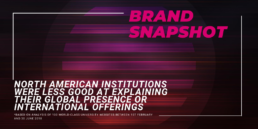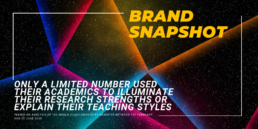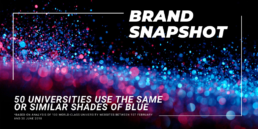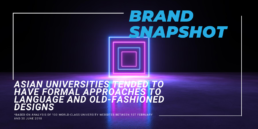Our 2017/18 research project, Brand Snapshot, reviewed the online brand profile of the best universities in the world – the top 50 in the world in all four main global rankings, plus W100 members and nominated peers.
Universities are putting more energy and thought into expressing their brand position as they compete for research funding, top students, and world-class academics. But there is a very weak understanding of brand difference or any formal impact assessment in the higher education sector other than via the rankings. As websites are one of the main ways audiences interact with universities and universities articulate their ‘brand’, our research project looked at brands online.
Each university was assessed by two independent analysts on key brand attributes between January and June 2018.
The research found that top universities really struggle to look or sound different when their websites are compared. 50 universities use the same or similar shades of blue, and the best online brands are not necessarily the highest ranked.
The project analysed the websites of 100 global institutions, finding that they adopted the same language, with phrases like ‘world impact’ and ‘challenging’ being repeated regularly.
“In such a competitive higher education world, universities have a long way to go in engaging the busy reader who looks at their website,” said Louise Simpson, Director of the World 100 Reputation Network. “Too many of them look and sound the same, and can’t explain what it is that makes them special. They really need to be much bolder both in the way they communicate, and in what they communicate. Good branding requires both creativity and decisiveness!”
Hypotheses to be Tested
• Student brands are better articulated than research brands.
• Brand propositions are not well differentiated between world top-ranked
universities; brand assets are similar among world top-ranked universities
• Brands are separated out between research, study and international, rather than
offered as an integrated expression of the whole university.
• There is no correlation between a high ranked university and a university with a
strong brand impact.
Our analysts looked at and assessed:
- First impressions – this included analysis of the logo, homepage design, use of images consistency of design and initial content of homepage
- News brand – analysts looked for how up-to-date the news is, how engaging it is, how it is presented and the balance of content
- Student brand – analysts looked for distinctiveness, prominence on the website and how well the students’ voice is represented on the website
- Research brand – analysts looked for distinctiveness, prominence on the website and how well the academics’ voice is represented on the website
- International brand – analysis of international activities and presence including strong international partnerships which can back up claims of being global
- City/location band – analysts looked at the extent to which the location of the university is used as a brand asset
- Partnerships –evidence of productive, fruitful strategic partnerships
- Institutional brand – recording straplines, campaigns, main messages and reputational claims the university makes
- Social media – analysts looked at how consistent the social media brand is with the website brand
Fifty Shades of Blue:Global universities struggle to look or sound distinctive
The Brand Snapshot research revealed:
Very few employed the techniques of brand campaigns that commercial companies use to clarify their points of difference or engage consumers with humour or succinct messages.
Those that appeared most distinctive were prepared to say what they were really focused on, with engaging story-telling, and strong visual and personalised approaches. Such as Helsinki, with its powerful public engagement campaigns and its revolutionary Think Corner, or Manchester, with five ‘research beacons’ of excellence.
North American institutions were less good at explaining their global presence or international offerings. Asian universities tended to have formal approaches to language and old-fashioned designs. Across all continents, universities relied on long lists of rankings or partnerships to justify their brand, rather than explain what they were really good at.
The top 25 online university brands in the W100 study were dominated by universities from the English-speaking world, such as Melbourne, Illinois, UBC, Birmingham and Queen’s Belfast; Keio University (Japan) stood out among Asian global universities; and Groningen, Helsinki, Aarhus and Karolinska were the European online brand leaders.
The final report from the research, is available for members of the W100 Network via news and resources page.
Further World 100 Research
- Riding the Tiger: Enhancing the Role of Reputation in International Partnerships
- The Digital Approach: Resources and structures for online communications
- Website Best Practice for World-Class Universities
- Rise and Fall: Managing reputation associated with significant world ranking change
- The R-Word: Communicating research at world-class universities
- more!
Research Downloads:
Available to Members Only
Become a Member
The World 100 Reputation Network is a group of the best universities in the world, delivering research that enhances reputation and offering leaders the chance to develop their own careers on a global stage. Members benefit from events and study tours, training, monthly media monitoring, and unique reputation research to provide institutional advantage.






